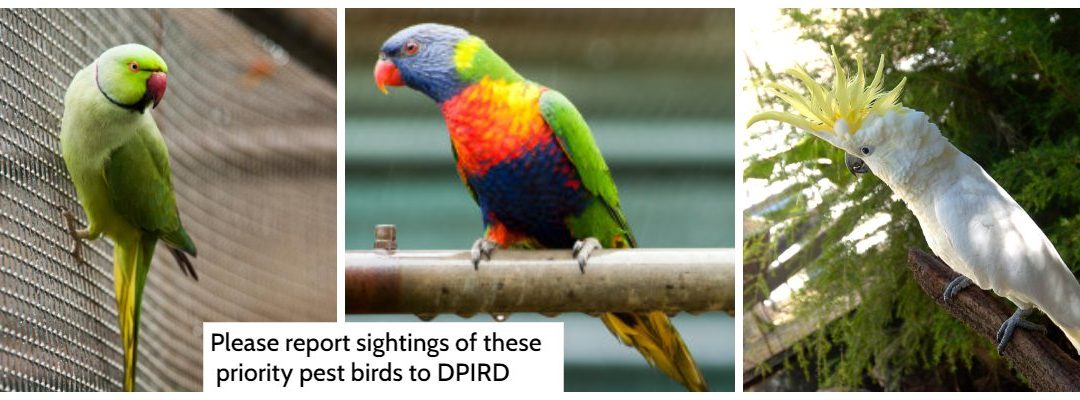DPIRD Media Release – 24 November 2022: Call for public to help locate declared pest birds
Even pretty birds can be a pest!
Members of the public across WA are being asked to help locate declared pest birds by keeping their eyes on the sky, and reporting any birds not usually seen in their area. Reports will support the surveillance and control programs currently being carried out by the Department of Primary Industries and Regional Development (DPIRD).
Noisy birds are not just annoying. Some are aggressive and destructive declared pests, and are found in WA only because they have escaped or have been released.
DPIRD’s biosecurity activities have had great success in protecting WA from some of the most destructive pest birds in the world, some of which are already widespread in other Australian states.
The 2021 Great Australian Bird Count found that six of the 20 most commonly seen birds around the country were declared pests that WA has successfully managed.
DPIRD surveillance and control activities have stopped these birds from entering and establishing in WA, or in areas where they are already established, have stopped their spread. This includes sparrows, common mynas, starlings, blackbirds, sulphur-crested cockatoos and rainbow lorikeets.
Public surveillance and reporting is critical to the ongoing success of these programs. It is not easy to find birds when they are hiding amongst the leaves, and so the more eyes, the sooner, the better. Early detection leads to the best chance of eradication and control.
What is a declared bird pest?
A bird becomes a declared pest when it is declared under WA’s Biosecurity and Agriculture Management Act 2007, due to behaviours such as:
- damaging fruit, cereal and horticulture crops
- displacing native species
- destroying ecosystems
- polluting and damaging houses and infrastructure
- transmitting diseases
- causing a general nuisance to humans and our way of life.
Some species can only be kept under permit, and some cannot be brought into WA at all. Find out more at DPIRD’s website.
Current priorities for DPIRD’s pest bird activities are:
- Sulphur-crested Cockatoos (read more at: Biosecurity Alert – Sulphur-crested cockatoo )
- Indian Ringneck Parakeets
- Rainbow Lorikeets
If you are in one of the areas listed below, and see one of these birds, contact DPIRD immediately through MyPestGuide Reporter or the Pest and Disease Information Service by phone 08 9368 3080 or e-mail: padis@dpird.wa.gov.au
- North of Perth (Muchea/Bullsbrook)
- South of Perth (Pinjarra, Meelon, Lake Mealup, Bouvard/Dawesville, Dunsborough and Witchcliffe)
- Do not report corellas as they are established and not possible to control
- Perth metropolitan area
- South of Perth (Brunswick)
- North and east of Perth (Gingin, Bindoon, Toodyay, Northam, York)
- South and east of Perth (Narrogin, Pinjarra, Bunbury)
- Do not report rainbow lorikeets found in the Perth metropolitan area, because they are established in this area and not possible to control


Recent Comments